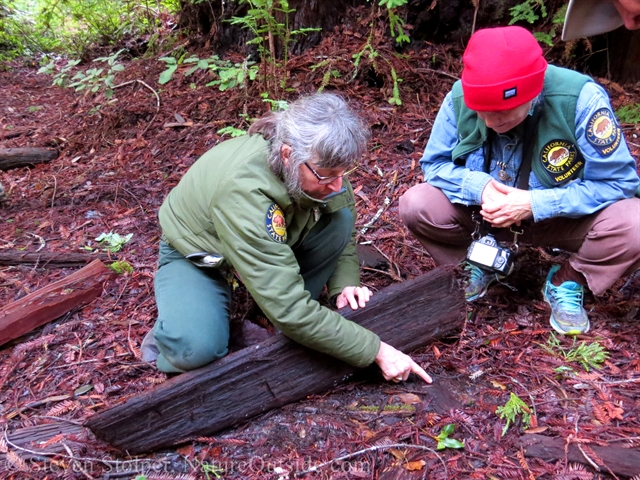
When people think herpetology, they immediately picture snakes. And in the past, I’ve written about my encounters with venomous rattlesnakes and the wildly colorful Coast Mountain Kingsnake.
But there are many spectacular herps in the world that are not snakes.
Expand Your Horizons
I recently attended a lecture and herpetology walk given by Lawrence Erickson. Lawrence is a self-trained herpetologist and member of the North American Field Herping Association.
The lecture is part of the training for docents at Big Basin Redwoods State Park. And it’s another example of how you get more out of volunteering than you put in. It was great to see familiar faces among the other docents and naturalists in the group. And I was eager to explore the redwood forest. In particular, I wanted to learn more about salamanders.
Salamanders are Stupendous
Salamanders are lizard-like amphibians. They tend to have elongated bodies and tails, but short limbs.
Salamanders are not reptiles! They are a unique group of animals with more than 600 species found throughout the world1. Reptiles are covered in dry scales, while amphibians have moist skins.
To me salamanders are the superheroes of the animal kingdom. They are adapted to both an aquatic and a terrestrial life. And to do this they morph their entire bodies. Talk about a superpower!
Like so many animals, salamanders are in decline. Habitat destruction is the primary culprit. People are co-opting wetlands, ponds, and lakes in which they live. People also change the environment by polluting or draining water from riparian habitat salamanders need to survive.
So I was eager to learn more about this underappreciated group of animals.
Turning Over Logs and Rocks
After the lecture, our small group dons rain gear to explore the redwood forest. These are among the greatest forests on planet Earth. And I feel like an ant as I peer up at the canopy.
But we don’t plan to hike far. The forest is deceptive. It appears deserted when it’s actually teeming with life. We humans are notoriously bad at comprehending scale. Just as these gigantic trees may never notice my passage. We humans often overlook thousands of organisms within 10 feet of us!
Our group checks to make sure we don’t have hand sanitizer or other chemicals on our hands. Many amphibians breathe through their skins. We also make sure our hands are wet, or wear “mud gloves” before handling the creatures. This is not hard to do when you’re looking for amphibians in a wet redwood forest.
Our strategy is to overturn rocks and logs, where amphibians like to shelter. But we’re careful to put them back in their original place, exactly as we found them. We want to preserve the “seal” that locks moisture underneath to create the environment amphibians need. If we think animals may be crushed, we replace the rock or log and then place the salamander along the edge. It will return itself to its home underneath the log.
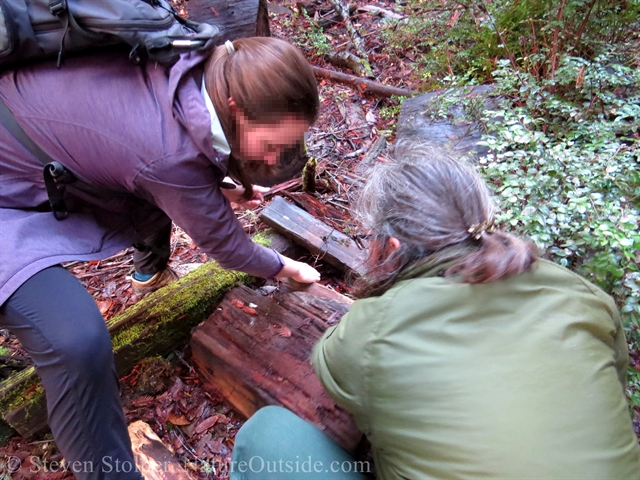
Turning over logs looking for salamanders on the forest floor
Perfect Weather – For Amphibians
Mist-like rain hangs in the air. It’s so transitory we can never tell when it’s raining and when it’s not. Moisture drips from every twig. And there’s a quiet patter of raindrops falling to the forest floor.
We fan out in small groups, looking like a weird foraging party of some long-lost tribe of hunter gatherers. The spirit of the forest is peaceful. And I feel sheltered as much by the trees as I do my fleece and rain jacket.
Slender Salamander
Our first discovery is a Slender salamander. This salamander does not breathe through lungs. Instead, it respires directly through its skin and the tissues lining its mouth. So it lives on land in damp environments and is never aquatic.
Since the Slender salamander lays its eggs on land, its young do not hatch in water and begin life as tiny swimming larvae breathing through gills. A young Slender salamander has a smaller version of the body it will have as an adult.
The Slender salamander is an ambush predator and eats a variety of invertebrates. This includes springtails, small beetles, snails, mites, spiders, and isopods.
Our Slender salamander coils into a defensive position that seems characteristic of the species.
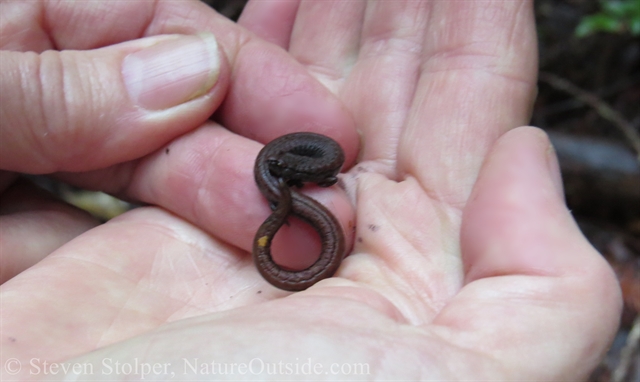
Slender salamander curls into a defensive posture. Its tail is closest to the camera.
People comment that it looks like a scary “number eight.” I remind them that it is seven, not eight that is scary. After all, seven ate nine! 🙂
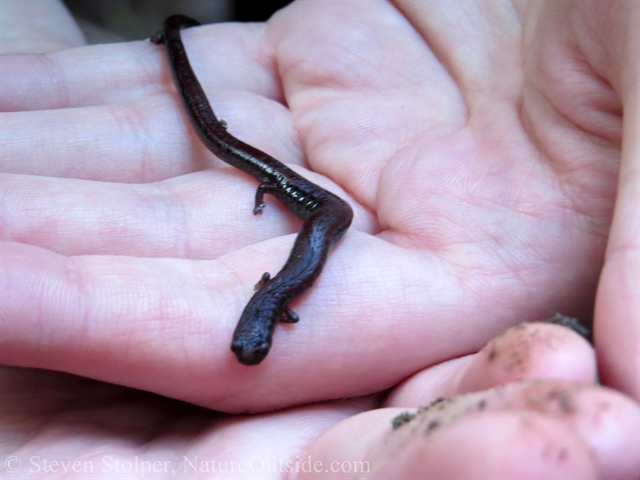
Slender salamander
Ensatina
Next we find an Ensatina. I’ve seen them before. But prior to today, I never understood what I was looking at.
The Ensatina looks similar to a California Newt. Adults measure about 3 – 6 inches (7.5 – 15.5 cm) tip to tail. But unlike the newts I’m used to seeing, it has 12-13 costal grooves. These vertical grooves between the ribs are where blood vessels and nerves run. And the grooves help transport water over the surface of the salamander’s body.
The most marked difference from newts are lighter orange “rings” that encircle the base of its limbs. I’ll use this in the future to help distinguish them from newts. They also have bulging eyes that are very different from newts.
Like the Slender salamander, the Ensatina lacks lungs. So it lives in moist places on land and is most active on rainy or wet nights. It lives underground during hot and dry periods, so it’s easy to miss. Ensatinas can live as long as 15 years.
Like some lizards in California, an Ensatina may drop its tail to distract a predator. It can re-grow its tail afterward.
The tail also contains a high density of poison glands2. The Ensanita can assume a defensive posture with its back swayed and tail raised. The tail secretes a milky white liquid. This noxious substance repels predators. If a person gets the poison on their lips, they will experience numbness for several hours.
Ensatinas eat invertebrates, including worms, ants, beetles, spiders, scorpions, centipedes, millipedes, sow bugs, and snails.
It uses its long sticky tongue to capture prey and pull it back into its mouth where it is crushed and killed, then swallowed.
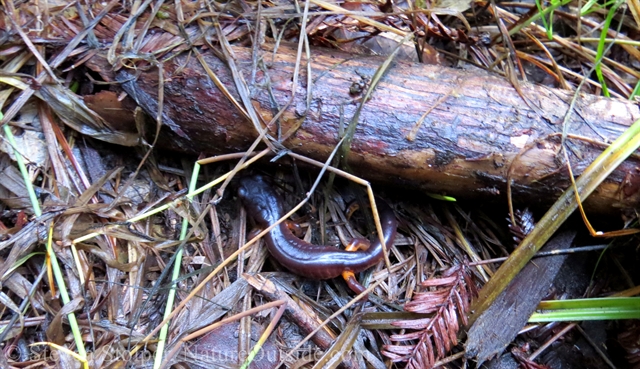
An Ensatina appears after I lift a fallen branch
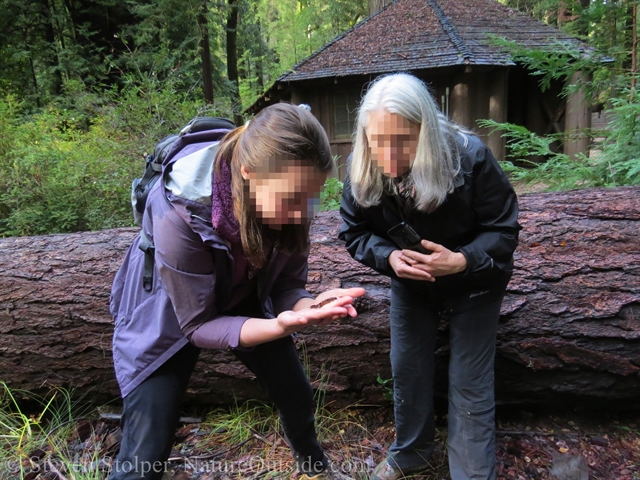
Ensatina in hand
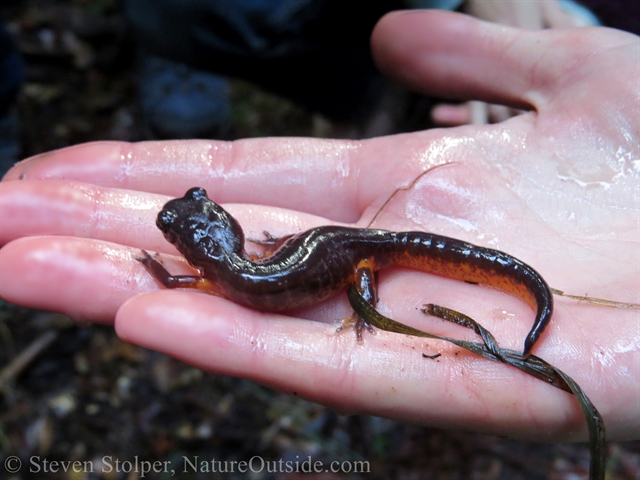
Ensatina. Notice the bulging eyes and lighter ring around the base of the limbs. You can also discern the costal grooves just forward of the hind leg.
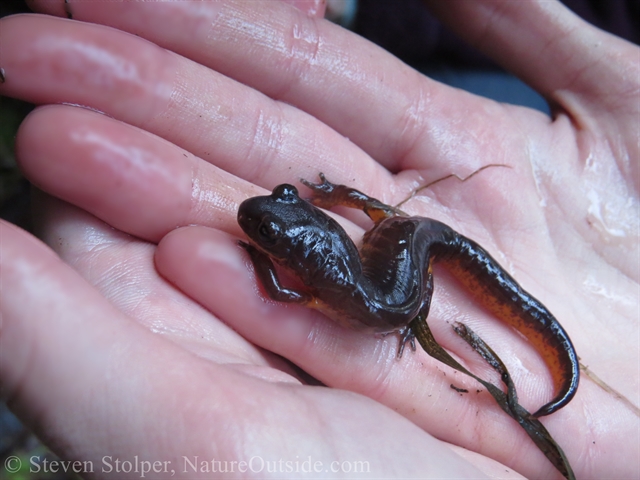
Ensatina
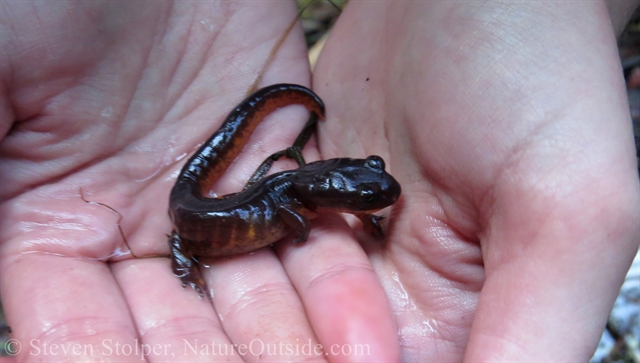
Ensatinas, like California newts, seem to crawl when held.
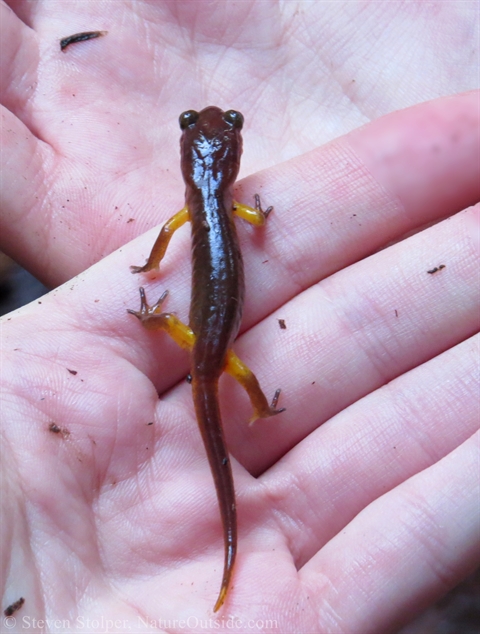
From above, it’s easy to see the light rings around the base of the limbs.
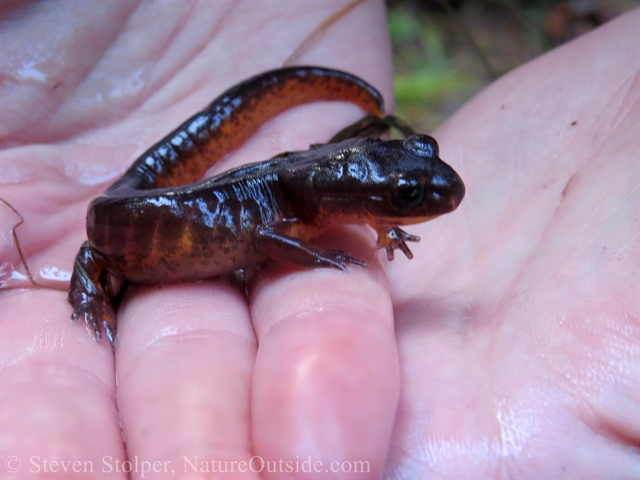
Smile!
Arboreal Salamander
Our last find is an arboreal salamander. As its name implies, it climbs trees.
A key feature is its toes. Their plainly squarish. To help it climb, the Arboreal salamander has a prehensile tail, which it often keeps coiled. They’ve been found up to 59 ft. (18 m) above the ground.
Like the Ensatina, it has costal grooves. But that’s where the similarities end. The Arboreal salamander is brown above with small cream to yellow spots all over its body. It’s the closest I’ve seen to having designer colors! The undersides of its tail and feet are dull yellow.
Arboreals are nocturnal. This may explain why I’ve never seen one before. They’re most active when soil moisture is high after the onset of rain.
Strong jaws and sharp teeth can produce a painful bite. But none of the ones we catch seem aggressive. I suspect they enjoy the warmth of our hands on this cold winter day.
The Arboreal salamander eats a variety of small invertebrates including millipedes, worms, snails, ants, termites, sowbugs, moths, and centipedes. It is also known to eat Slender salamanders. It captures prey with its tongue and crushes it in its mouth.
I’m shocked to learn that Arboreal salamanders may squeak when picked up or disturbed. But ours are not so inclined.
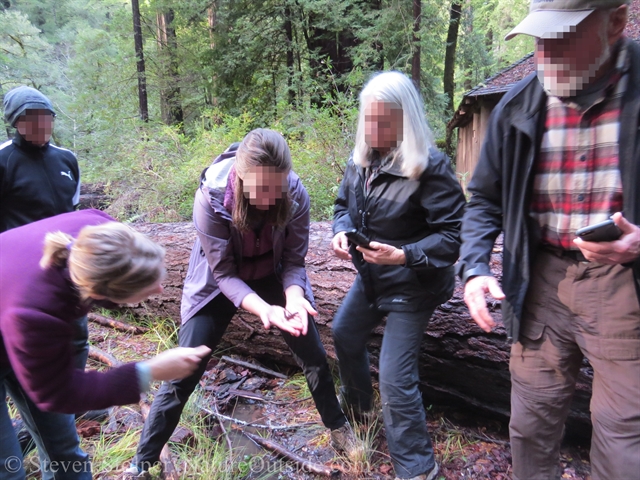
Picking up salamanders underneath the redwoods
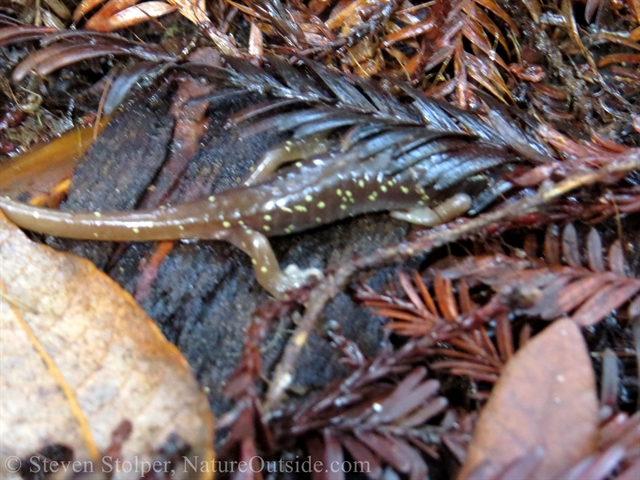
I find an Arboreal salamander underneath a log.
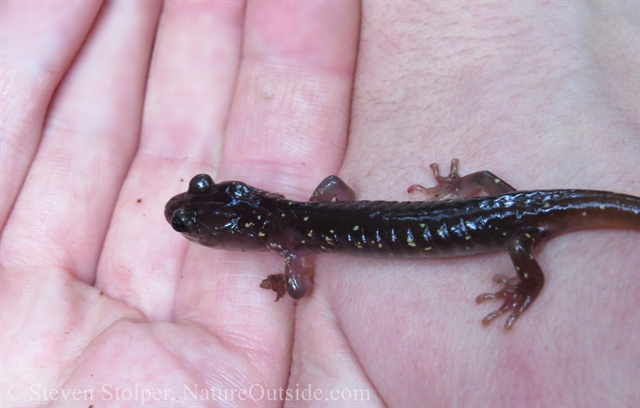
Arboreal salamander. Notice the “squareness” of the toes.
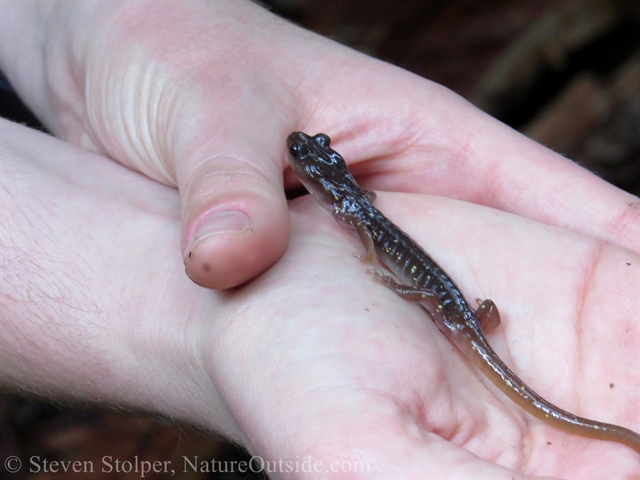
Arboreal salamander
Ladybird Convergence
I get a pleasant surprise when I notice a group of plants covered with Convergent lady beetles. These are the “ladybugs” most of us knew growing up. They’re named by the two white lines on their black prothorax (area behind the head). Notice how the two, straight white lines converge?
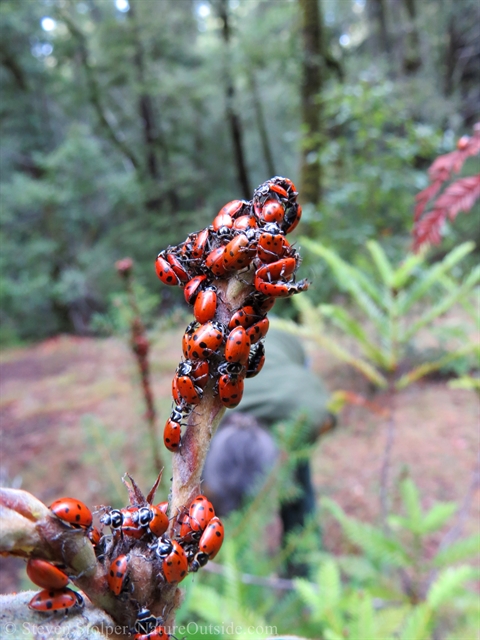
Convergent lady beetles
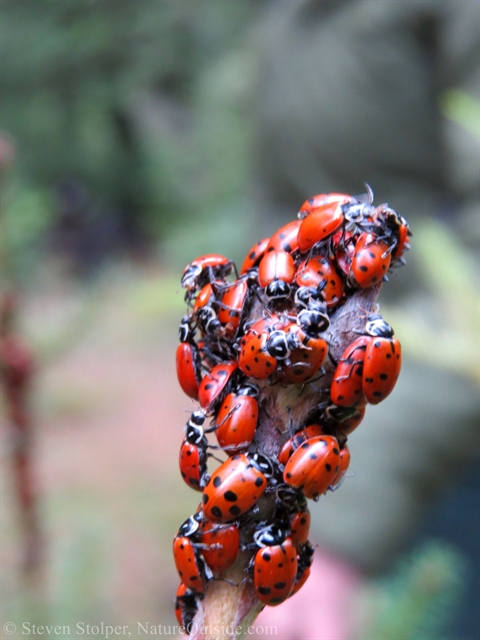
Convergent lady beetles. Notice the straight lines that converge on the black prothorax (area behind the head).
When temperatures are very high or low, or when food sources are insufficient for reproduction, adult convergent lady beetles enter into reproductive diapause3. Development stops so the creatures can survive the environmental stress. During these periods, adults may gather under tree branches or under rocks. I think this is what we’re witnessing.
Salamanders Near You
What type of salamanders live near you? Tell me about them using the comment section below.
References
- https://www.savethesalamanders.com/what-are-salamanders/
- http://www.californiaherps.com/salamanders/pages/e.e.xanthoptica.html
- http://entnemdept.ufl.edu/creatures/BENEFICIAL/convergent_lady_beetle.html
Related Articles on NatureOutside
Mountain Kingsnake – Beauty and Danger!
For fun facts and useful tips, join the free Bushcraft Newsletter.



Salamanders are stupendous! 💕
I agree, Kathryn! I’ve become a big fan of salamanders. 🙂